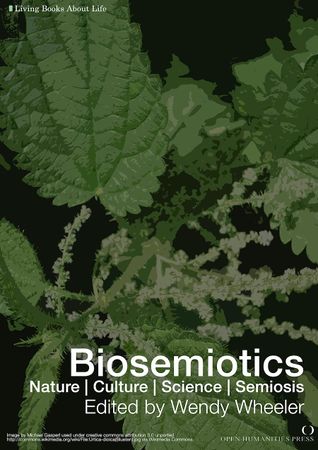Biosemiotics

Biosemiotics: Nature/Culture/Science/Semiosis
edited by Wendy Wheeler
Introduction
I’m pleased to be able to welcome readers to this Living Book titled Biosemiotics: Nature/Culture/Science/Semiosis. Biosemiotics – as its name suggests – is committed to science-humanities interdisciplinarity. As readers of these Living Books will doubtless know, this kind of interdisciplinarity is no mean task, but we have come a long way since C. P. Snow complained that humanities scholars knew nothing of the Second Law of Thermodynamics (Snow, 1998: 15). The sciences of modernity developed their methodological strengths and practical successes on the basis of ‘objective’1 observation and measurement, drawing on forms of description (preferentially mathematical models) as far removed as possible (which may not be that far (Pimm, 1981: 47-50; Manin, 2007; Lakoff & Núñez, 2000)) from the poetic, metaphor-rich and intersubjective language and the hermeneutical assumptions of the humanities. Although natural and cultural evolution (and, in the latter, the arts and humanities and the sciences) equally depend on continuities as well as what Thomas Kuhn called ‘revolutionary’ alterations,2 in the end both the practice of science and judgments concerning radical revisions of theory belong (as Kuhn noted in his 1969 ‘Postscript’) to the relevant scientific community (Kuhn, 1996). (more...)
Donald Favareau
The Evolutionary History of Biosemiotics
Thomas A. Sebeok
Semiotics and the Biological Sciences: Initial Conditions
Kalevi Kull
Jakob von Uexküll: An Introduction
Kalevi Kull
Organism As a Self-Reading Text: Anticipation and Semiosis
Kalevi Kull and Jesper Hoffmeyer
Thure von Uexküll 1908-2004
Jesper Hoffmeyer
Epilogue to Semiotics: Biology Is Immature Biosemiotics
Jesper Hoffmeyer
Semiotic Freedom: An Emerging Force
Kalevi Kull
Biosemiotics: To Know, What Life Knows
Kalevi Kull, Terrence Deacon, Claus Emmeche, Jesper Hoffmeyer, Frederik Stjernfelt
Theses on Biosemiotics: Prolegomena to a Theoretical Biology
Søren Brier
Cybersemiotics: An Evolutionary World View Going Beyond Entropy and Information into the Question of Meaning
Frederik Stjernfelt
The Semiotic Body
John Deely
The Green Book: The Impact of Semiotics on Philosophy'
John Deely
A Dialogue: "A Sign is What!?" ("a sign is that which presupposes an object")
John Deely
A Sign Is What? Original written dialogue
See also John Deely's Bibliography Dramatic Reading in Three Voices: 'A Sign is What?'
Terrence Deacon
Language and Complexity: Evolution Inside Out
Gregory Bateson
Chapters 2 and 3 of Mind and Nature: A Necessary Unity
Gregory Bateson and Mary Catherine Bateson
Chapters 2 and 3 of Angels Fear: Towards an Epistemology of the Sacred
Peter Harries-Jones
Bioentropy, Aesthetics and Meta-dualism: The Transdisciplinary Ecology of Gregory Bateson
Paul Cobley
Semioethics, Voluntarism and Anti-humanism
Susan Petrilli
Significs and Semioethics. Places of the Gift in Communication Today
Wendy Wheeler
Gregory Bateson and Biosemiotics: Transcendence and Animism in the 21st Century
